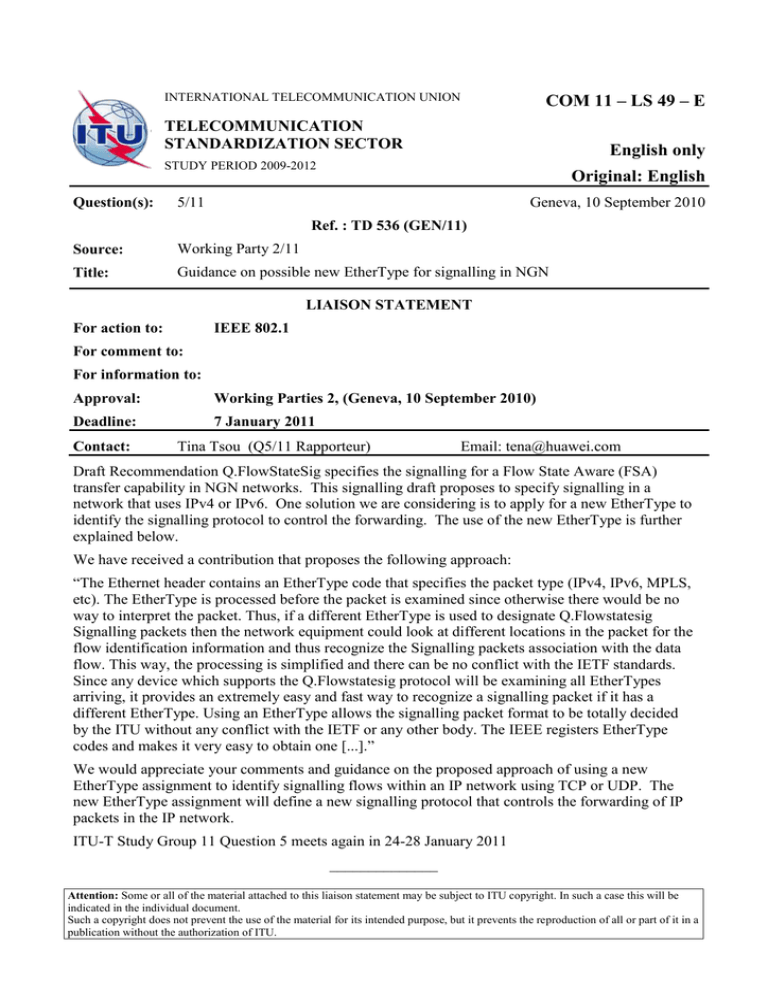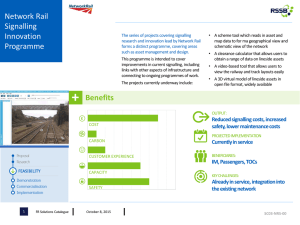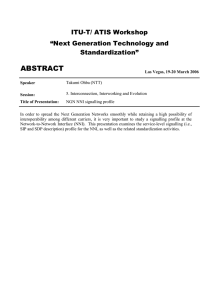COM 11 – LS 49 – E English only Original: English TELECOMMUNICATION
advertisement

COM 11 – LS 49 – E INTERNATIONAL TELECOMMUNICATION UNION TELECOMMUNICATION STANDARDIZATION SECTOR English only STUDY PERIOD 2009-2012 Question(s): Original: English 5/11 Geneva, 10 September 2010 Ref. : TD 536 (GEN/11) Source: Working Party 2/11 Title: Guidance on possible new EtherType for signalling in NGN LIAISON STATEMENT For action to: IEEE 802.1 For comment to: For information to: Approval: Working Parties 2, (Geneva, 10 September 2010) Deadline: 7 January 2011 Contact: Tina Tsou (Q5/11 Rapporteur) Email: tena@huawei.com Draft Recommendation Q.FlowStateSig specifies the signalling for a Flow State Aware (FSA) transfer capability in NGN networks. This signalling draft proposes to specify signalling in a network that uses IPv4 or IPv6. One solution we are considering is to apply for a new EtherType to identify the signalling protocol to control the forwarding. The use of the new EtherType is further explained below. We have received a contribution that proposes the following approach: “The Ethernet header contains an EtherType code that specifies the packet type (IPv4, IPv6, MPLS, etc). The EtherType is processed before the packet is examined since otherwise there would be no way to interpret the packet. Thus, if a different EtherType is used to designate Q.Flowstatesig Signalling packets then the network equipment could look at different locations in the packet for the flow identification information and thus recognize the Signalling packets association with the data flow. This way, the processing is simplified and there can be no conflict with the IETF standards. Since any device which supports the Q.Flowstatesig protocol will be examining all EtherTypes arriving, it provides an extremely easy and fast way to recognize a signalling packet if it has a different EtherType. Using an EtherType allows the signalling packet format to be totally decided by the ITU without any conflict with the IETF or any other body. The IEEE registers EtherType codes and makes it very easy to obtain one [...].” We would appreciate your comments and guidance on the proposed approach of using a new EtherType assignment to identify signalling flows within an IP network using TCP or UDP. The new EtherType assignment will define a new signalling protocol that controls the forwarding of IP packets in the IP network. ITU-T Study Group 11 Question 5 meets again in 24-28 January 2011 ______________ Attention: Some or all of the material attached to this liaison statement may be subject to ITU copyright. In such a case this will be indicated in the individual document. Such a copyright does not prevent the use of the material for its intended purpose, but it prevents the reproduction of all or part of it in a publication without the authorization of ITU.


